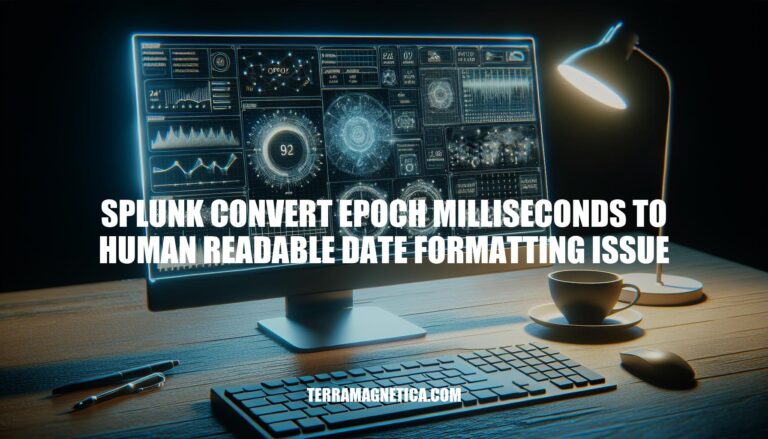


Converting epoch milliseconds to human-readable dates in Splunk is crucial for making log data more accessible and understandable. This conversion allows users to easily interpret timestamps, facilitating better analysis and troubleshooting. However, common challenges include ensuring accurate formatting and handling time zones, which can lead to discrepancies if not managed correctly.
Epoch time (or Unix time) is the number of seconds that have elapsed since 00:00:00 UTC on January 1, 1970. It’s a standard way for computers to track time.
Significance in data logging:
Why epoch milliseconds are used:
Need to convert to human-readable dates in Splunk:
When converting epoch milliseconds to human-readable dates in Splunk, several common issues can arise:
Incorrect Time Format Specification:
strftime(_time, "%Y-%m-%d %H:%M:%S") instead of strftime(_time/1000, "%Y-%m-%d %H:%M:%S.%3N").Division by 1000:
strftime(_time, "%Y-%m-%d %H:%M:%S") instead of strftime(_time/1000, "%Y-%m-%d %H:%M:%S").Time Zone Misalignment:
strftime(_time/1000, "%Y-%m-%d %H:%M:%S") without specifying the time zone.Field Extraction Errors:
eval incorrectly: eval humanTime = strftime(epoch_field, "%Y-%m-%d %H:%M:%S") instead of eval humanTime = strftime(epoch_field/1000, "%Y-%m-%d %H:%M:%S").Inconsistent Data Formats:
Addressing these issues is crucial for accurate and reliable data analysis in Splunk.
To convert epoch milliseconds to a human-readable date in Splunk, use the following solutions and best practices:
Search-Time Conversion:
| eval human_readable_time = strftime(epoch_time / 1000, "%Y-%m-%d %H:%M:%S.%3N")
This command divides the epoch time by 1000 to convert milliseconds to seconds and then formats it.
Index-Time Configuration:
[your_sourcetype]
TIME_FORMAT = %s%3N
TIME_PREFIX = your_time_prefix
[your_transform]
INGEST_EVAL = human_readable_time = strftime(epoch_time / 1000, "%Y-%m-%d %H:%M:%S.%3N")
%s%3N for milliseconds in TIME_FORMAT.These steps should help you accurately convert epoch milliseconds to a human-readable date in Splunk.
A company was facing difficulties in converting epoch time in milliseconds to a human-readable date format in Splunk. The logs contained timestamps in epoch milliseconds, making it challenging for analysts to interpret the data quickly.
Initial Analysis:
Configuration:
strftime function in Splunk to convert the epoch time. The function strftime(X, Y) takes an epoch time value X and formats it according to the string Y.Implementation:
sourcetype=your_sourcetype | eval readable_time=strftime(epoch_time/1000, "%Y-%m-%d %H:%M:%S") | table _time, readable_time
epoch_time/1000 converts milliseconds to seconds, and strftime formats it to YYYY-MM-DD HH:MM:SS.Validation:
This approach streamlined the data analysis process and improved the overall efficiency of the team’s workflow.
It’s essential to follow these key points:
These best practices ensure that your data is accurately and efficiently converted, making it easier for analysts to interpret and work with. By following these guidelines, you can streamline your workflow and improve overall efficiency.
In Splunk, epoch time is often represented in milliseconds, which can be challenging to read and understand. To resolve this issue, you can use the strftime function to convert the epoch time to a human-readable format. This involves dividing the epoch time by 1000 to convert it from milliseconds to seconds, and then formatting it according to your desired date and time format.
When implementing this conversion in Splunk, it’s crucial to perform the conversion as late as possible in your search query to maintain performance. This approach ensures that the original data remains intact and is not altered during the conversion process.
By following these steps and best practices, you can accurately convert epoch milliseconds to human-readable dates in Splunk, making it easier for analysts to work with and interpret the data.